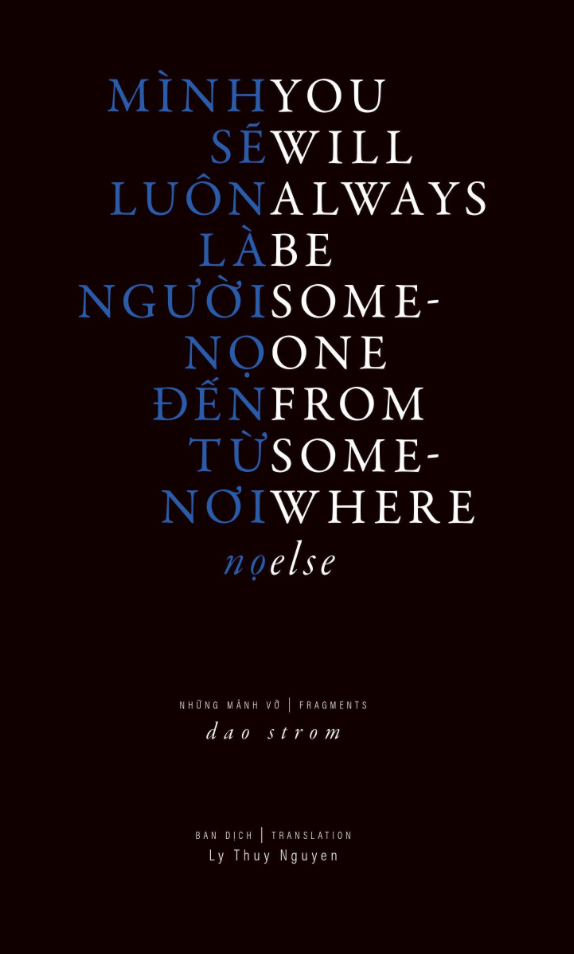
When I read Dao Strom’s work I am transported — as though I were suddenly small enough to lie back on an alder leaf that has drifted from its branch and landed on the surface of a stream. And so when I write “I am transported,” I mean it figuratively, of course, but with my imagination serving as the captain of the ship of my person, I also mean it quite literally. Dao Strom’s new hybrid work, You Will Always Be Someone From Somewhere Else by AJAR Press, combines poetry, songs, and images, and conjures itself into a braided river that invites the reader into a lotic ecosystem, which is to say an ecosystem of running water.

I remember, albeit barely, learning about braided rivers in school. From above, the sinuous ribbons of water curve and drift, undulate, cross and return. They are beautiful. If I were to personify braided rivers — and this is exactly what I intend to do — I would say that they are curious and responsive. I would say that they are willing to sacrifice efficiency and the direct route for the right path.
From a piece written for Vela Magazine, Dao Strom writes:
“Hybridity is a way of saying we are neither this nor (completely) that; at the same time we are this AND we are that, maybe even that other that, too. And it’s all subject to change. We might dissolve or evolve any boundaries. We will not stay put where you think you’ve safely placed us, named us, tried to corral us. Neither this, nor that. Neither of here nor there, wholly. Such territories are not always supported, condoned, understood, or even accurately perceived by either the ‘heres’ or ‘theres’ the artists have strayed from. They abide in a state of ambiguity — hard-to-define, unwilling to capitulate, limbo-ed in a sort of accepted tenuousness of being.”
Because, per Strom’s definition, hybridity is slippery idea, and because her own work is shaped by aquatic inclinations, I am, in turn, inclined to explore the idea of her hybrid works as lotic systems. This becomes all the more fitting especially because rivers show up in Strom’s writing again and again.
From the Latin lotus meaning washed, the word lotic refers to flowing water. These are the characteristics that contribute to the uniqueness of lotic ecosystems: unidirectional flow; a state of continuous physical change; a high degree of spatial and temporal heterogeneity at all scales; high variability between lotic systems; and specialization of biota in order to live with flow conditions.
After Dao Strom left Vietnam in 1975 with her mother and brother, her family settled into a new life in California Gold Country. I, too, am from California Gold Country. I, too, am shaped by the rivers in these regions, rivers that rough tumble out of the Sierra Nevada Mountains toward the foothills, the San Joaquin Valley, eventually the Pacific Ocean.
Hybrid works are dynamic in the same way that rivers are, seemingly always in the act of transforming into something else, not unlike mountain springs that shift into creeks, rivers, delta, and sea. And this metaphor is not to be confused for an assertion that hybridity grows ever more expansive. Hybrid work can do that, but it doesn’t have to; but, it must shift shape and form, flowing between identity, becoming a named thing, then another, then something in-between. Strom’s You Will Always Be Someone From Somewhere Else includes imagery and text in the form of poetry and song. Her memoir — We Were Meant to be a Gentle People — holds much of the same material and, thus, there is an element in the fragmented text of her newest work that might also be considered memoir, when cutting its particular flow between riverbanks.
This state of flow is a defining characteristic of hybrid works, as they refuse to settle and pool into historically-defined genres such as fiction or nonfiction.
In We Were Meant to be a Gentle People, Strom considers how sounds and song transitioned into a physical representation — words on the page:
& before we had language ((those relics we now call words)) surely we must’ve begun with the tones alone… We intoned all of our need for telling. This was back before they — certain inclined ones of us — discovered how to snatch the tones, as well as the words, from the air and concretize them into shapes, symbols, notes. Our voices now subverted: into materia. So that now when I write I it to be but a substitute for the singing that once was enough between us.
This idea, that the written word is a physical manifestation of sound, is the necessary foundation for the second characteristic of a lotic system: a state of continuous physical change. Strom plays with the physicality of text deftly, using placement of text on the page, parentheticals and text enclosed in greater than and less than symbols, plus and minus signs, and recurring shapes such as the triangle. Strom’s work is not simply about the content, but how the content is shared and, quite literally, shaped and formed as characters on the blank page.
The third characteristic of a lotic system is: a high degree of spatial and temporal heterogeneity at all scales. This characteristic requires additional definitions. Heterogeneity signifies diversity. Spatial heterogeneity refers to the variance in distribution and concentration of a species in an ecosystem. Temporal heterogeneity marks a point in time when a physical disturbance — an ordinary out-of-the-ordinary event like a windstorm or fire — occurs. Let me say this in my own words. A river is a place riddled with life. This life is not sprinkled evenly throughout the river, but exists in pockets of varying density. What is most beautiful to me about this characteristic is that it acknowledges, for example, a pool where dozens of fish reside, but it also references their complete absence in other locations.
Dao Strom’s work is as much about absence as is it about presence. “All those memories I may belong to, do not belong to me,” Strom writes in You Will Always Be Someone From Somewhere Else. There are gaps in her memory and, thus, her story. There are erasures — not only did Strom leave her country of origin at so young an age as to not remember it, her family filled in the blanks, at times, with fiction over fact. Until the age of fifteen, Strom was told that her birth father had died. In actuality, he had been unable to conceive of leaving South Vietnam and, so, stayed, when her, her mother, and her brother left in 1975. Again, Strom writes about memory: “This is an era of re-membering. An era of re-membering means there are things we have forgotten. Let’s (please) re-member this.”
Additionally, content is revisited again and again throughout Strom’s two hybrid works. In this way, does this content not resemble a species, like the brook trout, that swim languidly in separate areas of the river, in separate schools of varying numbers?
In interview with David Naimon of “Between the Covers,” Dao Strom discusses the importance of ambiguity and contradiction. Her work, like much hybrid work, refuses to identify as any singular thing. It is not simply nonfiction, or memoir, or poetry, or fiction. Hybrid work is more interested at what lies at the intersections of these definitions which, let’s be honest, are made up anyway. Hybrid work is more interested in what happens when we pretend such genres don’t exist — if they don’t exist, then the rules contained by them do not have to be followed. Also, hybrid work is more interested in uncertainty than certainty. This is not to say that Dao Strom, or others writing hybrid work, does not use craft deftly. In her interview with Naimon, Strom notes that her work is seemingly the exact opposite of the traditional Western narrative, aka “the Hero’s Journey,” aka a story driven by a main characters actions through plot. “Hybrid work is the opposite,” Strom concurs, and is much more “passive” and “indirect,” much more interested in “interiority” and “a certain amorphousness.”
In the sciences, variability refers to lack of a fixed pattern. And while I would assert that Dao Strom’s works teach the reader how to read them and, essentially, contain a rhythm and pattern unto themselves, the nature of hybridity is that there are no two works alike. You Will Always Be Someone From Somewhere Else is a unique entity unto itself. Strom seems aware that her work occurs outside an existing context — that is quite nearly the point, or so it seems to me. There is a concrete intentionality about the book that declares itself to be beyond the fixed pattern.
The last characteristic of a lotic system — if this metaphor can be indulged just a little further — is that biota is specialized to live with flow conditions. Biota are the living organisms and processes found in a riverine environment. Again, and like the species that find themselves dripping with river water, I link this characteristic to content. The content of hybrid work necessitates hybridity. Oftentimes, and assumedly so with Dao Strom, a writer and artist finds that, in order to tell the story they must tell, multiple approaches and modalities are employed.
Hybrid works consider that which lies between. Hybridity is concerned with the middle space, the flowing river space. Dao Strom’s magnificent You Will Always Be Someone From Somewhere Else is a river unto itself, at times frothing whitewater, at times gentle eddy, always a journeying current that simultaneously invites reflection on where the writer has come from and curiosity about where she is going.
In the United States alone, there are over 250,000 rivers totaling over 3.5 million miles of flowing water. Rivers provide important habitat for a variety of species of both plants and animals. They transport water and nutrients. Their path shapes the surface of the Earth. This is all to say that if this idea of hybrid literature as a lotic ecosystem is going to work, the result of encountering such pieces must yield similar results.
At the top of this piece, I said that reading Dao Strom’s work transports me. And when I wrote “I am transported,” I meant it figuratively, of course, but with my imagination serving as the captain of the ship of my person, I also meant it quite literally. The physical, flowing, biota-hosting, heterogeneous and diverse arena that is the river of You Will Always Be Someone From Somewhere Else transports me to the many places — real and, out of necessity, imagined — that have and continue to shape the work and world(s) of Strom. And, like a river, her work transports those places, memories, and even the erasures, to me.
When I read Dao Strom’s work I am transported — as though I were suddenly small enough to lie back… was originally published in Anomaly on Medium, where people are continuing the conversation by highlighting and responding to this story.
